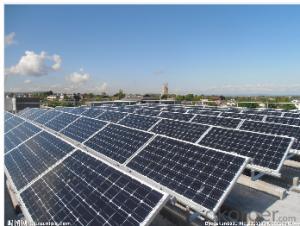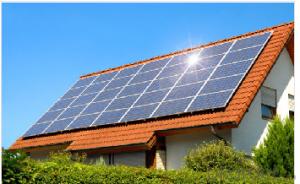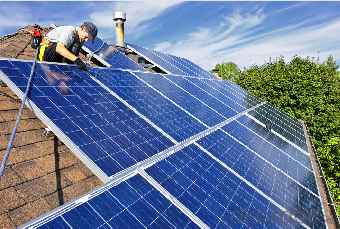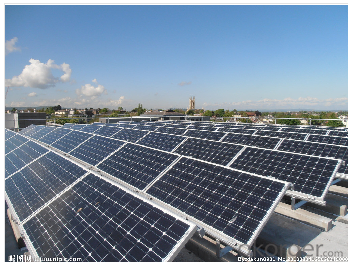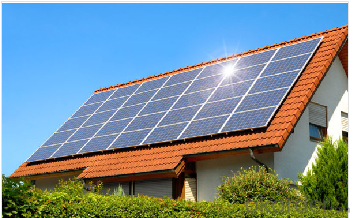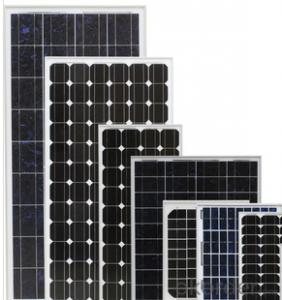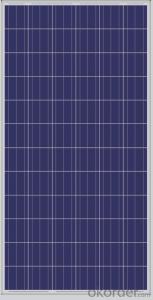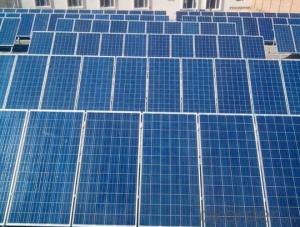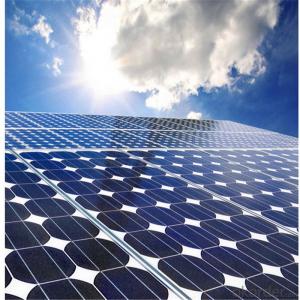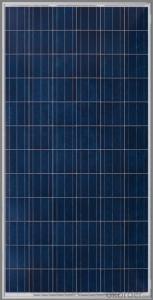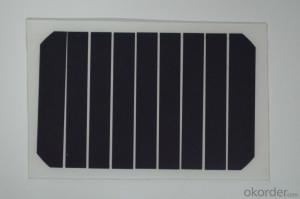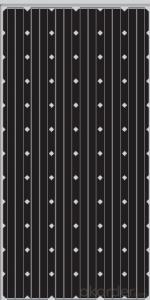Solar Panels 300 Watts from CNBM
- Loading Port:
- China main port
- Payment Terms:
- TT OR LC
- Min Order Qty:
- 1 pc
- Supply Capability:
- 10000000 pc/month
OKorder Service Pledge
OKorder Financial Service
You Might Also Like
Product Description:
Solar Module
ABOUT YINGLI GREEN ENERGY
Yingli Green Energy Holding Company Limited (NYSE: YGE) is one of
the world’s largest fully vertically integrated PV manufacturers, which
markets its products under the brand “Yingli Solar“. With over 7.0GW
of modules installed globally, we are a leading solar energy company
built upon proven product reliability and sustainable performance. We
are the fi rst renewable energy company and the fi rst Chinese company
to sponsor the FIFA World CupTM.
PERFORMANCE
- High effi ciency, multicrystalline silicon solar cells with high transmission
and textured glass deliver a module effi ciency of up to 16.0%,
minimizing installation costs and maximizing the kWh output of your
system per unit area.
- Tight positive power tolerance of 0W to +5W ensures you receive
modules at or above nameplate power and contributes to minimizing
module mismatch losses leading to improved system yield.
- Top ranking in the “TÜV Rheinland Energy Yield Test” and the
“PHOTON Test” demonstrates high performance and annual energy
production.
RELIABILITY
- Tests by independent laboratories prove that Yingli Solar modules:
Fully conform to certifi cation and regulatory standards.
Withstand wind loads of up to 2.4kPa and snow loads of up to
5.4kPa, confi rming mechanical stability.
Successfully endure ammonia and salt-mist exposure at the highest
severity level, ensuring their performance in adverse conditions.
- Manufacturing facility certifi ed by TÜV Rheinland to ISO 9001:2008,
ISO 14001:2004 and BS OHSAS 18001:2007.
WARRANTIES
- 10-year limited product warranty1.
- Limited power warranty1: 10 years at 91.2% of the minimal rated power
output, 25 years at 80.7% of the minimal rated power output.
1In compliance with our Warranty Terms and Conditions.
QUALIFICATIONS & CERTIFICATES
IEC 61215, IEC 61730, MCS, CE, ISO 9001:2008, ISO 14001:2004, BS OHSAS
18001:2007, PV Cycle, SA 8000
ELECTRICAL PERFORMANCE
Electrical parameters at Standard Test Conditions (STC)
Module type YLxxxP-29b (xxx=Pmax)
Power output Pmax W 260 255 250 245 240
Power output tolerances ΔPmax W 0 / + 5
Module effi ciency ηm % 16.0 15.7 15.4 15.1 14.8
Voltage at Pmax Vmpp V 30.3 30.0 29.8 29.6 29.3
Current at Pmax Impp A 8.59 8.49 8.39 8.28 8.18
Open-circuit voltage Voc V 37.7 37.7 37.6 37.5 37.5
Short-circuit current Isc A 9.09 9.01 8.92 8.83 8.75
Electrical parameters at Nominal Operating Cell Temperature (NOCT)
Power output Pmax W 189.7 186.0 182.4 178.7 175.1
Voltage at Pmax Vmpp V 27.6 27.4 27.2 27.0 26.8
Current at Pmax Impp A 6.87 6.79 6.71 6.62 6.54
Open-circuit voltage Voc V 34.8 34.8 34.7 34.6 34.6
Short-circuit current Isc A 7.35 7.28 7.21 7.14 7.07
STC: 1000W/m2 irradiance, 25°C cell temperature, AM1.5g spectrum according to EN 60904-3.
Average relative effi ciency reduction of 3.3% at 200W/m2 according to EN 60904-1.
NOCT: open-circuit module operation temperature at 800W/m2 irradiance, 20°C ambient temperature, 1m/s wind speed.
OPERATING CONDITIONS
Max. system voltage 1000VDC
Max. series fuse rating 15A
Limiting reverse current 15A
Operating temperature range -40°C to 85°C
Max. static load, front (e.g., snow) 5400Pa
Max. static load, back (e.g., wind) 2400Pa
Max. hailstone impact (diameter / velocity) 25mm / 23m/s
CONSTRUCTION MATERIALS
Front cover (material / thickness) low-iron tempered glass / 3.2mm
Cell (quantity / material / dimensions /
number of busbars)
60 / multicrystalline silicon / 156mm x 156mm / 2 or 3
Encapsulant (material) ethylene vinyl acetate (EVA)
Frame (material / color / anodization color /
edge sealing) anodized aluminum alloy / silver / clear / silicone or tape
Junction box (protection degree) ≥ IP65
Cable (length / cross-sectional area) 1000mm / 4mm2
Plug connector
(type / protection degree) MC4 / IP67 or YT08-1 / IP67 or Amphenol H4 / IP68
PACKAGING SPECIFICATIONS
Number of modules per pallet 29
Number of pallets per 40' container 28
Packaging box dimensions
(L / W / H) 1700mm / 1135mm / 1165mm
Box weight 568kg
Unit: mm
• Due to continuous innovation, research and product improvement, the specifi cations in this product information sheet are subject to change
without prior notice. The specifi cations may deviate slightly and are not guaranteed.
• The data do not refer to a single module and they are not part of the offer, they only serve for comparison to different module types
- Q: Hello, I am shopping for solar panels for my home and there are so many to choose from. My house uses 40 Kw of power a day. If you had to choose from the output power of a solar panel from below, which one would you choose and why would you choose it? 2 Volts 4 Amps 48Watts2 Volts 8.5 Amps 02Watts6 Volts 7 Amps 2Watts24 Volts 4.2 Amps 00.8Watts24 Volts 8 Amps 95Watts
- There is more to sizing a system than simply selecting panels. I would suggest that you contact a solar installer to do a bid on your system. The quote should be free, and you can always say no. If a house used 40 kWh per day in our area, that would suggest a 6 kW array to offset substantially all the energy usage over the course of a year. Serious panels tend to be in the neighborhood of 200 watts nowadays, and that would mean 30 of those. You could size the system smaller, of course, if you wanted to offset a smaller percentage of your electricity. If there is any way that you can reduce the energy requirments, that will save you more money than putting in big solar. For example, if you can cut that in half by adding insulation and more efficient appliances, you will save more money than if you got a big array to power everything as-is.
- Q: I want to build a solar panel
- Make okorder
- Q: We are thinking about useing solar panels for our house.Does anyone know about solar panels? If so could you please tell me some information on them,and the cost for a home,to install them.
- Solar electricity systems can save you more money. Want to know more features about Solar Panels Companies? Contact us today for more details.
- Q: Are there any government incentives or rebates for installing solar panels?
- Yes, there are various government incentives and rebates available for installing solar panels. These incentives can include federal tax credits, state and local grants, and utility rebates. These programs aim to encourage the adoption of renewable energy sources and can significantly offset the upfront costs of installing solar panels. It is advisable to check with local authorities and utilities to determine the specific incentives and rebates available in a particular area.
- Q: What is the difference between Photovoltaic Panels and Solar Panels?
- Solar panels collect energy from the sun and then provide it to a system that typically concentrates it. Solar energy comes to us in the form of heat and light. Photovoltaic panels take the light energy from the sun and convert it to electricity. Although the maximum efficiency is around 42% in the lab most commercial models you will see are from 8 to 22% efficient. Adding collectors together concentrates this energy into usable amounts. Solar thermal panels are from 60 to 80% efficient. They come in many different types and collect the heat energy from the sun. That heat may then be stored in some form of thermal mass where it becomes concentrated sufficiently to be used. Solar thermal panels can be used to heat a medium. This can be a phase change material, air, or water. Solar thermal air panels are cheap to make and offer a quick pay back period. Solar thermal panels for some heating and hot water systems circulate water. Vacuum tube collectors are solar thermal panels that may heat water directly or a phase change materials. They can operate better in cloudy and colder weather with more efficiency. Air and water panels are often called flat panels as a way to contrast them with vacuum tube collectors. Solar thermal panels often lead to some form of energy storage called thermal mass (water tanks, phase change materials, masonry walls and rocks.) Photovoltaic panels make electricity that is stored in batteries, used or sent to the general grid. Panels are only one way to collect solar thermal energy. Other types of collectors are used commercially and are often called simply solar concentrators. Some are called parabolic trough collectors and parabolic dish collectors.
- Q: How to Compare Solar Panels? ?
- Each okorder / When comparing the cost of different solar panels, bear in mind the variation in return each panel can provide. More expensive solar panels may provide better value for money in the long run. Greater power out.
- Q: I know there's different brands of solar panels and they cost different amounts.But if anyone know the average price of one solar panel could you help me out?Also could you please list the size of the solar panel.
- Hard to answer, it really varies. A rooftop electric panel will typically be about 200 watts or so, and an installation would have many of them. Here's an example: Suntech STP 200 These Modules Provide: 200 Watts VOC 33.40V VMP 26.20V ISC 8.2amp IMP 7.63amp Width Height Deep 39 58 3/8 3/8 $488.00
- Q: i want to charge my mytouch 3g with solar panel(s) it has a 500mah 3.7v 4.4wh batterieswhat do i need to charge it can i use RadioShack 0.5W Solar Panel 4.5V or RadioShack? W Solar Panel 4.5V
- see u have to make ur own ckt for this ur solar panel generate DC if u want to charge ur phine then its convenient way to harge with ur charger for this do this search for net to convert DC-AC convertor since ur charger work on AC so when ur solar panel generate DC it convert into AC that will charge ur phone in ckt u need this thing filter and amp ie the DC voltage come from solar panel 2 DC to AC convertor 3 AMP for AC 4 filter for AC and u are done....... fine ckt from google.....
- Q: I am looking at building my own solar panels to at least help cut down the rising energy bill. I know its expensive. I already have the solar cells so no need to worry about listing that. But i am looking at wiring it directly into the house. Is there any parts that you could list for me, that would be great. thanks
- Have okorder . This could undoubtedly assist person!
- Q: Can solar panels be installed on waste treatment plants?
- Yes, solar panels can be installed on waste treatment plants. In fact, waste treatment plants provide ample space and suitable infrastructure for the installation of solar panels. This can help offset the electricity consumption of the plant and reduce its carbon footprint, making it a sustainable and environmentally friendly option. Additionally, solar panels can contribute to cost savings by generating clean energy on-site.
Send your message to us
Solar Panels 300 Watts from CNBM
- Loading Port:
- China main port
- Payment Terms:
- TT OR LC
- Min Order Qty:
- 1 pc
- Supply Capability:
- 10000000 pc/month
OKorder Service Pledge
OKorder Financial Service
Similar products
Hot products
Hot Searches
Related keywords

